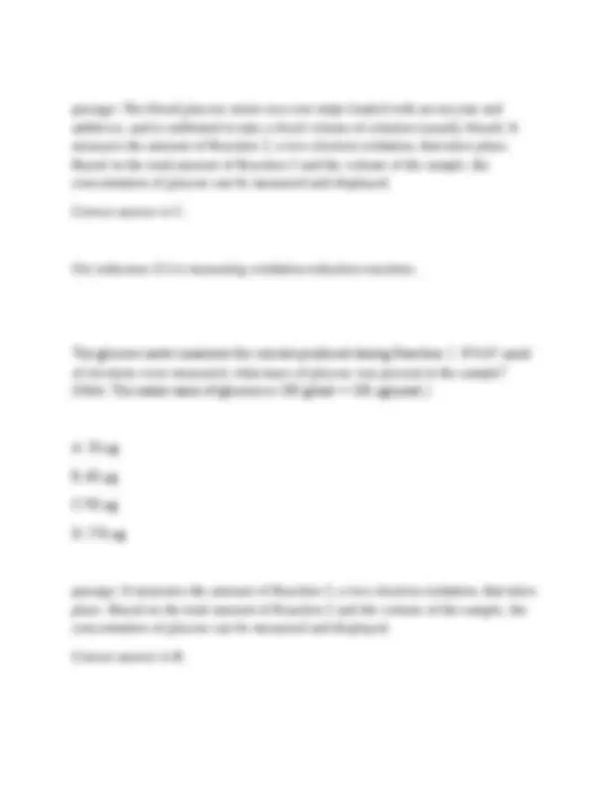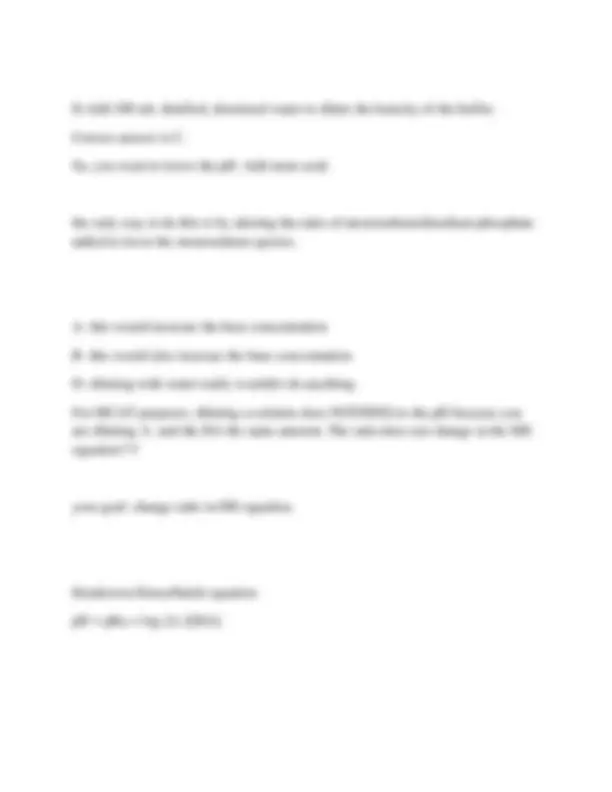














































Study with the several resources on Docsity

Earn points by helping other students or get them with a premium plan


Prepare for your exams
Study with the several resources on Docsity

Earn points to download
Earn points by helping other students or get them with a premium plan
Community
Ask the community for help and clear up your study doubts
Discover the best universities in your country according to Docsity users
Free resources
Download our free guides on studying techniques, anxiety management strategies, and thesis advice from Docsity tutors
AAMC FL 3 FULL EXAM REVIEW 2025QUESTIONS AND ANSWERS GRADED A+ AAMC FL 3 FULL EXAM REVIEW 2025
Typology: Exams
1 / 52

This page cannot be seen from the preview
Don't miss anything!













































Which of the carbons in Compound 3 corresponds to the carbon marked with an asterisk in Compound 4a?
Correct answer is B.
Aldol condensation happens at the alpha-hydrogen, which is the hydrogen located on the alpha carbon (carbon next to the carbonyl carbon).
Aldol condensation
Aldehyde + Aldehyde
Ketone + Ketone
Aldehyde + Ketone
Catalyzed by an acid or base (base used here).
Deprotonation: base deprotonates α-H, leaving the enolate ion.
Nucleophilic attack: enolate ion as the nucleophile attacks the carbonyl carbon to form an alkoxide ion.
Protonation: alkoxide ion is a stronger base than a hydroxide ion (b/c EDG alkyl attached to O) and deprotonates water to complete the aldol.
Condensation: strong base (OH-) does E2 dehydration rxn by deprotonation of the α-C to make the enal (subsequent double bond and original carbonyl).
-> Aldol is unstable and is easily dehydrated by heat or a base to an enal which is stabilized by conjugated double bonds.
What can be inferred from the results of Scheme A about the relative thermodynamic stabilities of Compounds 4a and 4b?
A.They are equally stable.
B.Compound 4a is less stable than Compound 4b.
C.Compound 4a is more stable than Compound 4b.
D.Nothing can be inferred about relative thermodynamic stabilities.
Correct answer is C.
The two major factors for what products are preferentially formed are: thermodynamic and kinetic. thermodynamic control will favor the more energetically stable products, even if they require a higher activation energy and more time to produce. Kinetic control will favor products that form more quickly;
c= q/v
c x v= q
It gives us the capacitance in mF, NOT F so make sure to convert. (1 milifarad = 0.001 farad).
100mF x 0.001F/1mF = 0.
It tells us the battery volts are 12V.
(0.1)(12) = 1200e-
=1.2J
The work done to charge the capacitor is U = 1/2 C x V^
1/2 (100e-3)(12)2= 7.20 J
Capacitance equation:
C = Q/V
Capacitance = Charge / Voltage
Capacitance - farads; f
Charge - coulombs; c
Voltage - volts; v
Energy of a capacitor equation:
U = 1/2QV = 1/2CV^
C = capacitance
Suppose that the railcar passes by a horn that is emitting a sound with frequency f. Which of the following describes the frequency f' that the person on the railcar hears?
A. f prime > f before passing the horn, f prime < f after passing it
B. f prime < f before passing the horn, f prime > f after passing it
C. f PS-10-1-prime.gif = f before passing the horn, f PS-10-1-prime.gif = f after passing it
D. f PS-10-1-prime.gif > f before passing the horn, f PS-10-1-prime.gif > f after passing it
Correct answer is A.
f prime > f before passing the actual horn; f prime < f after passing it
1 kW = 1,000 W
Equation for power
P = W/t
(work in J/ time in S)
P = f X v
(force in N and velocity in m/s)
If the generator-brake system alone were engaged when the railcar was moving, which of the following graphs would most accurately represent the subsequent speed of the railcar?
Correct answer is D.
The passage mentions that the force decelerates at a constant 5,000N at 40m/s and that the force declines linearly. This makes choice A tempting; HOWEVER, the question asks for SPEED/VELOCITY. If the acceleration is decreasing at a linear fashion, then that means the velocity is decreasing in an exponential fashion.
The slope of a velocity-time curve is acceleration, and a linear velocity-time curve would correspond to constant deceleration, NOT one that keeps dropping which is what the question is referring to.
Decelerating force
Curved graph because it is not at a constant deceleration.
Constant deceleration would be a linear, decreasing graph.
The relative thermodynamic stability of isomeric organic compounds can be inferred from which of the following types of experimental data?
A.Boiling points
B.UV-visible absorption spectra
C.Mass spectroscopic fragmentation patterns
D.Heats of combustion
Correct answer is D.
A - seems like a good choice at first but boiling points are a measure of strength for INTRERmolecular, forces that hold molecules together. Thermodynamic stability of a compound is determined by the INTRAmolecular forces.
Thermodynamic stability is determined by the amount of heat produced.
less heat, more stable
Metal > Ionic > Polar covalent > Nonpolar covalent
Types of intermolecular forces
Intermolecular forces that exist between molecules is much weaker than intramolecular forces of attraction
London dispersion forces - falls under the category of van deer Waal's forces. The weakest of the intermolecular forces and exist between all types of molecules, whether ionic or covalent—polar or nonpolar. The more electrons a molecule has, the stronger the London dispersion forces. I.e., bromine, Br2, has more electrons than chlorine, Cl2, so bromine will have stronger London dispersion forces than chlorine, resulting in a higher boiling point for bromine, 59C, compared to chlorine, -35C.
Dipole-dipole interactions -
These forces occur when the partially positively charged part of a molecule interacts with the partially negatively charged part of the neighboring molecule. Prerequisite to this type of attraction to exist is partially charged ions - polar covalent bonds like HCl.
Dipole-dipole interaction > hydrogen bonding > London dispersion attraction
Radioactive tritium (3H) labeled guanine has been used to measure the rate of biochemical processes that involve its binding or incorporation.
Given that water is the solvent for this type of experiment, what is the best site for tritium labeling?
A.I
B.II
C.III
D.IV
Correct answer is A.
B, C, and D - the nitrogens could easily pick up a solvent proton and exchange it with its own radio labeled tritium. Nitrogen has a lone pair of electrons as well that can easily pick up a proton from the solvent.
Because the solvent is water, whatever site we choose should not interact with water for proton exchange. You do not want this hydrogen to come off, so you need to choose a position that is not likely to be protonated or have a lone pair to
Consider the following data.
Substance Ka K w /Ka
H2CO3 4.3 × 10-7 2.3 × 10-
HCO3- 5.6 × 10-11 1.8 × 10-
Based on these data, HCO3- is best categorized as:
A.a base since Ka > Kb for this ion.
B.a base since Kb > Ka for this ion.
C.an acid since Ka > Kb for this ion.
D.an acid since Kb > Ka for this ion.
Correct answer is B.
1.8 e-4 is bigger than 5.6e-
Kw = Ka x Kb
Kw = autoionization constant (10^-14)
Ka = acid dissociation constant
Kb = base ionization constant
Passage: Gray, granular zinc metal (2.0 g) and purple iodine crystals (2.0 g) are added to an Erlenmeyer flask containing
25 mL of methanol (CH3OH).
There is a 2:1 ratio of moles of iodine atoms to zinc atoms in the product is consistently obtained. The mass of iodine and reacted zinc equals the mass of product.
The limiting reagent in the experiments described in the passage is:
A.iodine.
B.zinc.
C.methanol.
D.iodide.
Correct answer is A.
represented by the energy of the activated complex MINUS the energy of the reactants. Activation energy is kinetic controlled and IS affected by catalysts.
A - reactants minus energy of products would be the Gibbs free energy for the reverse reaction, NOT activation energy. This is thermodynamically controlled and NOT affected by catalysts.
B - products minus the energy of the reactants is the Gibbs free energy, not activation energy.
C - this combines the activation energy and Gibbs free energy which is NOT what the question is asking for.
In its lowest-energy electron configuration, zinc has a:
A.filled 3d energy level and a filled 4s energy level.
B.half-filled 3d energy level and a filled 4s energy level.
C.filled 3d energy level and a half-filled 4s energy level.
D.half-filled 3d energy level and a half-filled 4s energy level.
Correct answer is A.
Electron configuration of zinc, shorthanded, is 1s2 2s2 2p6 3s2 3p6 4s2 3d1 OR [Ar] 3d10 4s2.
Remember when you do the short-hand method for electron configurations - when you get to the D block, you have subtract ONE from the period number!
Lowest energy confirmation = the element in its natural state.
All shells are filled (note - it's not gonna react very well if the shells are filled)
C - if this was the correct answer, zinc would have 11 valence electrons, not 12 (meaning it would be 3d9 4s2, NOT 3d10.
What type of reaction is occurring between I2 and Zn?
A.Acid-base (neutralization)
B.Precipitate formation
C.Oxidation-reduction
D.Chelate formation
Correct answer is C.
Both iodine and zinc change oxidation states as evidenced by the conversion of iodine to iodide.
B - girl.. you haven't ever come across "precipitate formation" as a type of reaction. A dead giveaway is the reduction table that they give you. Pay attention to details!!!
What is the period of the voltage source that operates the plasma pencil?
passage image: Graph shows that the voltage is on for 500ns and then off for 500ns until the beginning of the next pulse.
A.2000 ns
B.1500 ns
C.1000 ns
D.500 ns
Correct answer is C.
Period is the amount of time from the beginning of a wave or signal to the BEGINNING of the next wave or signal.
What is the maximum energy of the UV photons generated by this plasma pencil? (Note: Speed of light is c = 3.0 × 108 m/s; Planck's constant is h = 6.63 × 10- J•s.)
passage: sterilization is also caused by the UV radiation (200-300 nm) generated by the electron transitions within the plasma plume.
Correct answer is D.
e= hc/lamda
e= (6e-34 x 3e8)/(200e-9)
Energy is maximized when frequency is high and wavelength is low. You are told to find the MAX energy. Therefore you need to use the smallest wavelength because energy and wavelength are inversely related so 200nm in this case.
200 nm = 200e-
Equation for finding energy associated with wavelength
E = hc/lambda
h = planks constant (6.63x10^-34 J•s)
c = speed of light (3.0x10^8 m/s)
lambda = wavelength